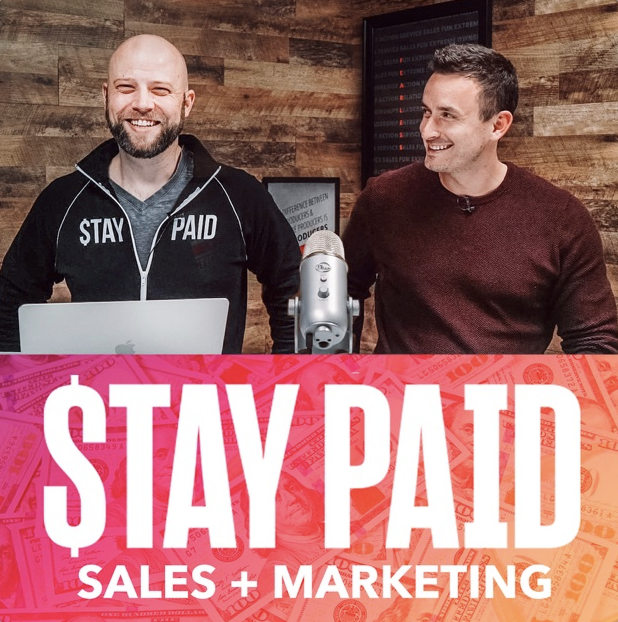Adam Weiss is a sales expert with a passion for helping teams achieve their full potential. He’s built multiple multi-million dollar sales teams, while personally hiring and training over 150 sales professionals.
Today on Stay Paid, Adam explains how you can use social media platforms like LinkedIn and Instagram to turn prospects into clients.
Key Points:
- LinkedIn and Instagram offer amazing opportunities to generate free, qualified leads.
- You need to establish common ground before making a deal.
- A combination of social media prospecting and cold calling will yield the best results.
Q: Introduce yourself to our audience.
I did not start out in sales. I had wrestled in high school and planned on doing sports at the college level, but that goal was taken away when I broke my back.
I found myself at the end of high school with all my plans brought to a screeching halt. I needed money. I lived in a small suburb of Wichita, Kansas, where I learned the plumbing trade. I did that for two years or so before realizing that was not for me.
I ended up leaving the union and started selling insurance. When I thought of sales, I only knew of two things: insurance and cars. I didn’t want to sell cars. The first place that hired me was an insurance agency. I was there for 90 days before I realized I needed to get out of Kansas and to a different environment with more opportunity.
I got married at 19. I came home one day and said, “Pack up. We’re moving.”
We moved to Miami, and I started selling stocks. I did pretty well for a young kid. We ended up moving back to Kansas City for personal reasons. I got into marketing for a big company. I became a big performer there for about two years, before transitioning back to Miami and into finance.
I got my first VP position at 24. I was in a weird position where I was younger than a lot of people I was managing. I had to learn really quickly what it takes to be a leader.
I was at that job for about 18 months. Not long after that, I left corporate America and struck out on my own. It’s come with its own set of challenges, but I should have done this a lot sooner.
I spent so long honing my craft, so I felt more prepared when I made the leap. But there’s a lot you have to learn.
Q: What are you doing now?
We are an alternative lending firm. We fund the growth of small and medium-sized businesses. I realized there was a big gap in the industry. There was a lack of integrity in how things were handled—but, from an employee standpoint, there was only so much I could do. The only way to do something bigger was to build my own company from the ground up. This is the most profitable thing for my team, and it’s also the best thing for my clients.
Q: How are you generating leads in this current business?
When I look back at my sales career, one of the things I’ve done better than anybody has been focusing on the top of the funnel. Nobody ever had a bigger pipeline than me, so, naturally, I outperformed everyone.
One of the ways I did that was through social media, especially LinkedIn. I’ve probably closed almost eight figures in total sales through LinkedIn, with at least a couple thousand leads.
The phone is another great avenue. I look at lead generation in a unique way. There are people who go all in on social media or on cold calling, but I think there’s got to be a good mix of the two. I always have things going on with social media, and the second component is being able to pick up the phone and generate leads that way.
The guys I have with me now are hunting on social media in the morning, then following up on the phone in the afternoon.
Q; What does the top of your funnel look like?
The top of our funnel is somebody who has some sort of interest in growing or expanding their business. We either have to provoke them to come to us or generate interest to the point where they want to have a conversation. We have certain Instagram hashtags we follow, as well as companies whose activities we monitor. We find different pockets of people in those ways.
On LinkedIn, there are certain groups that offer great opportunities. You have to identify who your target is. Are they a referral partner, or are they a client?
On LinkedIn, you can also search different topics. Search for “Sales” and click “Groups.” Then you can see all the different groups. You can join all of them, go in and read, or post content. Some of these groups have thousands of posts. It’s the same way on Facebook.
Q: How often are you engaging with people in these groups?
We reach out to people directly a lot more than we do specific content creation. Obviously, you want the content so you can get known and get social credibility. But a lot of our activity comes from directly messaging people and getting into their inbox.
I’ve found that the best thing to do is research, then find good things to talk about. Don’t do it the lazy way—the lazy way doesn’t pay. If you have a generic message that you copy and paste, nobody cares. They don’t know you.
You need to find some common ground first. You can’t take the conversation to higher ground until you establish common ground.
What sort of emotional triggers does my message give? Does it seem like I care about people, or does it seem pitchy? Does it seem like I have an ulterior motive?
Another issue is when you try too hard to not sound pitchy. You’ve got to have that happy medium.
“Here’s why I’m reaching out. Here’s what I want to accomplish with you. At the end of the day, I’d like to jump on the phone and have a conversation with you.”
Q: Have you tested this against other approaches?
I had to learn the hard way that the copy and paste approach doesn’t work. I was sending tons of messages but not getting any return on them. There’s a buzzword these days: “massive action.” By itself, it means nothing. That’s because high execution with crappy strategy doesn’t work.
I was spending all this time on social media, and I put the phone on the backburner. My pipeline was drying up, which led to frustration. Then I got desperate. The more desperate you get, the less leads you get.
What happens to most people like this is that they give up and go get another job. Then they’ll become a top performer again, only to fizzle out and go get another job. This happens simply because their strategy isn’t sound.
Q: What does your prospecting strategy look like for most people?
We do LinkedIn prospecting every morning. We’ve found that social works best in the morning, and calling works better in the afternoon. We get better results trying to book appointments for the afternoon.
If we don’t get a response, we might shoot a message back in three days, and ask a question to generate some interest—not a sales question or another pitch. We might mention something they posted or a comment they left on someone else’s posts.
We’ve got a couple different tiers. We have our hottest prospects, which are the ones we find from other posts (about a service similar to ours). There are a limited number of these per day. The second tier we go after is 50–70 direct messages to people a day, emphasizing quality of messages over quantity.
It has been a little harder to track this than it is to track calls. We rely on people to be accountable. But I have an idea of the results that people should be getting, so I’m able to look at the results and figure out how much work they’re doing.
Q: Are you getting the same level of results on Instagram that you do on LinkedIn?
It’s a little different. We keep an eye out for sponsored content, which gives us a chance to connect with free leads by commenting and messaging them.
We do a lot with hashtags. We target a lot of contractors, restaurants, and retail establishments. We’ll use the hashtag #miamibusiness. We’ll go through that hashtag and find a ton of companies that want to grow and expand.
We try to reach out to those companies and start a conversation in an attempt to ultimately get them on the phone.
Q: Which routines have driven success for you?
When I first got into sales, I was fortunate enough to have some mentors around me who were honest about my need for self-development. I’m naturally a type-A person with no people skills. I had to develop myself a lot to get to the point where I could be considered for a leadership position.
For 3–4 years straight, I read at least a book a week. I was just trying to get every piece of information about business, sales, and how to deal with people. I read everything I could that would help me become better at the things I’d need to do in the future.
Q: What advice would you give to your younger self?
I’d tell myself to not fear the unknown so much. The whole reason I wound up in a corporate environment was because I made decisions based on what was comfortable—not what would give me the most opportunity. I would tell myself not to think so much about what things looked like in the present, but to take opportunities based on what they would mean for me a few years in the future.
I would also tell myself to learn to be better with money. I would wind up in financial pits, which would affect my mind-set. This made me unable to grasp what other people would be willing to spend on things. I started thinking that because I couldn’t afford my product, no one else would be able to, either. It made me more focused on chasing dollars than on chasing relationships.
Action Items:
- Find local hashtags in your community and engage with the people using those hashtags.
- Spend five minutes every morning adding connections on social media.
Connect with Adam:



















 Soundcloud
Soundcloud iHeart Radio
iHeart Radio Spotify
Spotify Spotify
Spotify


